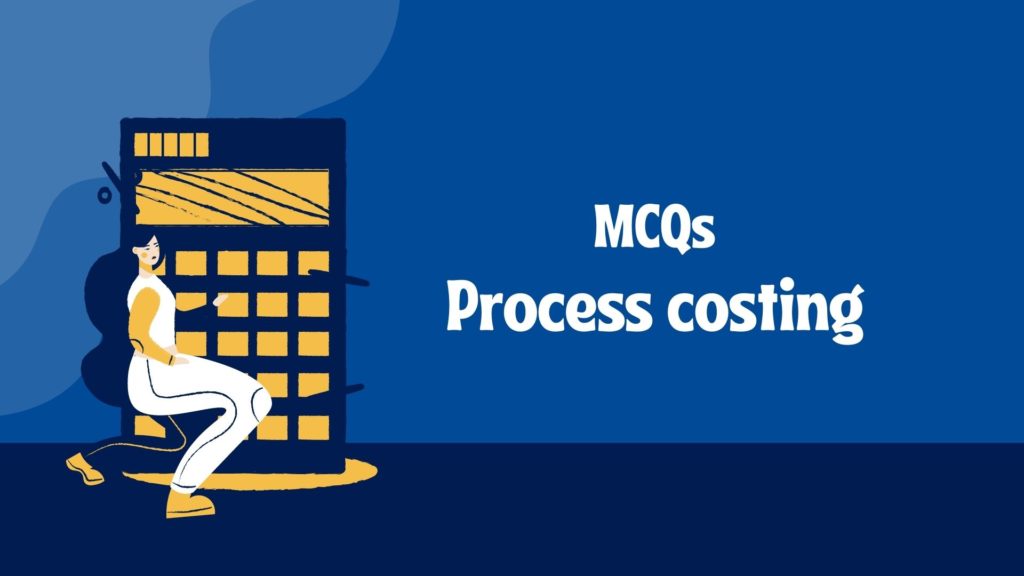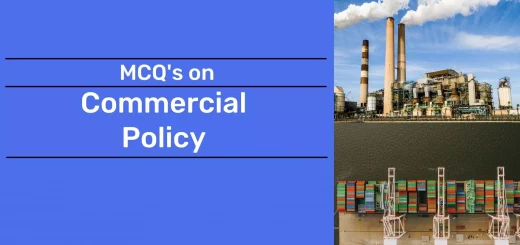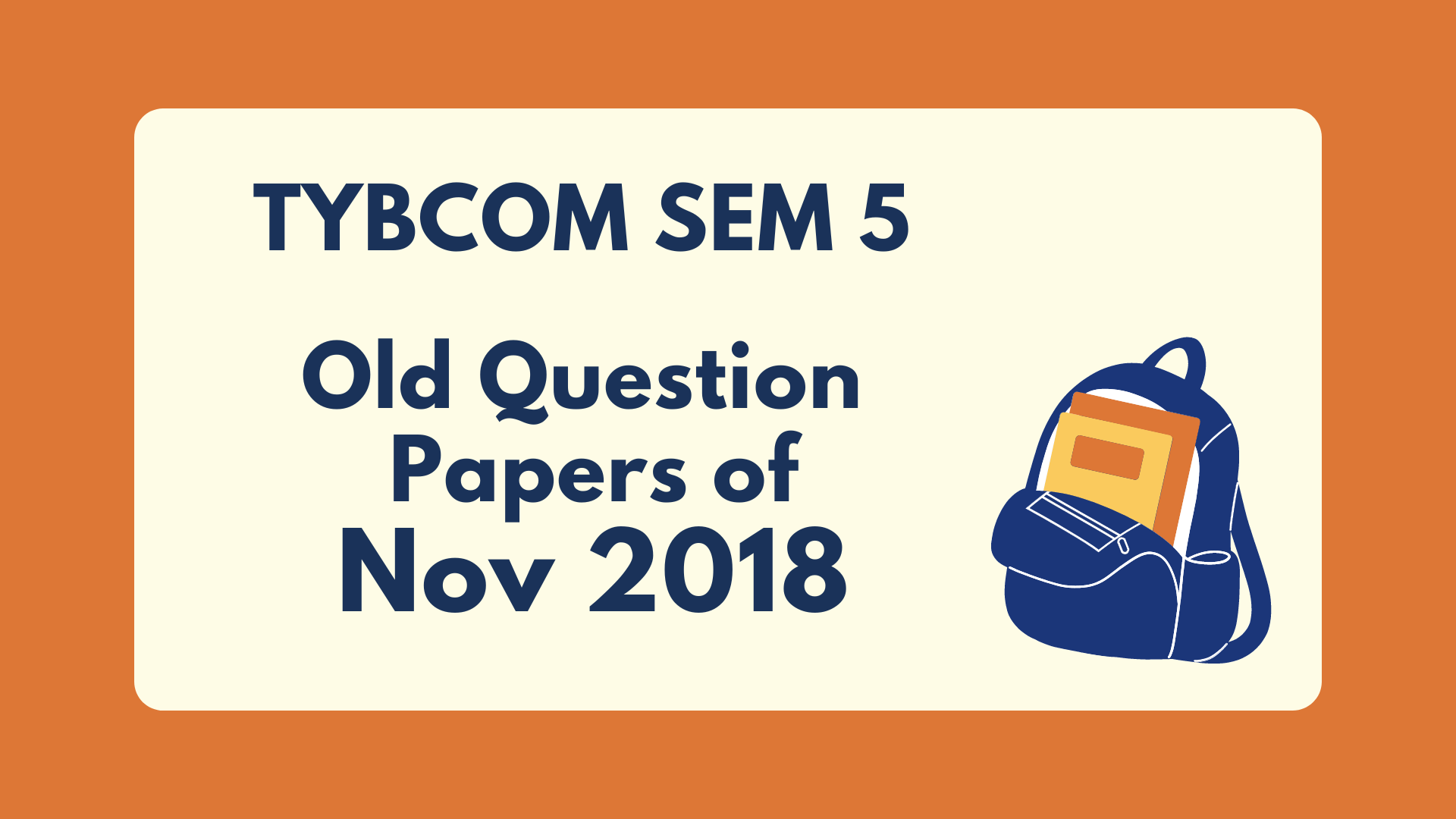40+ Process costing MCQ | Cost Accounting MCQs (Free Resource)
Process costing MCQ

1. Process costing is applied when
(a) small number of different products are manufactured
(b) large number of different products are manufactured
(c) large number of identical products are manufactured
(d) small numbers of customized made-to-order products are manufactured
2. Which of the following does not use process costing?
(a) Oil refining
(b) Distilleries
(c) Sugar
(d) Air-craft manufacturing
3. Which cost accumulation procedure is most applicable in continuous mass-production manufacturing environments?
(a) Standard
(b) Actual
(c) Process
(d) Job order
4. Which of the following statements is false?
(a) In process costing, cost is accumulated according to processes or departments
(b) In job costing, the basis of cost accumulation is job order or batch size
(c) In process costing, cost is accumulated on time basis
(d) In job costing, cost is computed at the end of the cost period
5. Process Cost is based on the concept of
(a) Average Cost
(b) Marginal Cost
(c) Standard Cost
(d) Differential Cost
6. Normal Loss is equal to
(a) Normal Output – Actual Output
(b) Actual Output – Normal Output
(c) Input X % of Normal Loss
(d) None of the above
7. Normal Output is equal to
(a) Input – Abnormal Loss
(b) Input – Normal Loss
(c) Input – Abnormal Gains
(d) None of the above
8. Unit Cost is equal to
(a) Normal Cost ÷ Normal Output
(b) Total Cost ÷ Normal Output
(c) Normal Cost ÷ Total Output
(d) Total Cost ÷ Total Output
9. Abnormal Loss is equal to
(a) Input – Actual Output
(b) Actual Output – Normal Output
(c) Normal Output – Actual Output
(d) Actual Output – Input
10. Abnormal Gains are equal to
(a) Actual Output – Normal Output
(b) Normal Output – Actual Output
(c) Actual Output – Input
(d) Input – Actual Output
| Answers: 1)large number of identical products are manufactured 2)Air-craft manufacturing 3)Process 4)In job costing, cost is computed at the end of the cost period 5)Average Cost 6)Input X % of Normal Loss 7)Input – Normal Loss 8)Normal Cost ÷ Normal Output 9)Normal Output – Actual Output 10)Actual Output – Normal Output |
11. Process cost is very much applicable in
(a) Construction Industry
(b) Pharmaceutical Industry
(c) Airline Company
(d) None of these
12. In process costing, each producing department is a
(a) Cost unit
(b) Cost center
(c) Investment center
(d) Sales center
13. Which of the given units can never become part of first department of Cost of Production Report?
(a) Units received from preceding department
(b) Units transferred to subsequent department
(c) Lost units
(d) Units still in process
14. When production is below standard specification or quality and cannot be rectified by incurring additional cost, it is called
(a) Defective
(b) Spoilage
(c) Waste
(d) Scrap
15. What will be the impact of normal loss on the overall per-unit cost?
(a) Per unit cost will increase
(b) Per unit cost will decrease
(c) Per unit cost remain unchanged
(d) Normal loss has no relation to unit cost
16. 12,000 kg of material were input to a process in a period. The normal loss is 10% of input. There is no opening or closing work-in-progress. Output in the period was 10,920 kg. What was the abnormal gain/loss in the period?
(a) Abnormal gain of 120 kg
(b) Abnormal loss of 120 kg
(c) Abnormal gain of 1,080 kg
(d) Abnormal loss of 1,080 kg
17. Wastage of raw material during a manufacturing process is 20% of input quantity. What input quantity of raw material is required per kg of output?
(a) 0.8 kg
(b) 1.2 kg
(c) 1.25 kg
(d) 1.33 kg
18. 400 liters of a chemical were manufactured in a period. There is a normal loss of 25% of the material input into the process. An abnormal loss of 5% of material input occurred in the period. How many liters of material (to the nearest liter) were input into the process in the period?
(a) 500
(b) 520
(c) 560
(d) 571
19. A company uses process costing to value its output. The following was recorded for the period:
Input materials 2,000 units at Rs 4.50 per unit
Conversion costs Rs 13,340
Normal loss 5% of input valued at Rs 3 per unit
Actual loss of 150 units
There were no opening or closing stocks.
What was the valuation of one unit of output to one decimal place?
(a) Rs 11.8
(b) Rs 11.6
(c) RS 11.2
(d) Rs 11.0
20. A company uses process costing to value its output and all materials are input at the start of the process.
The following information relates to the process for one month:
Input 3,000 units
Opening stock 400 units
Losses 10% of input is expected to be lost
Closing stock 200 units
How many good units were output from the process if actual losses were 400 units?
(a) 2,800 units
(b) 2,900 units
(c) 3,000 units
(d) 3,200 units
| Answers: 11)Pharmaceutical Industry 12)Cost center 13)Units received from preceding department 14)Spoilage 15)Per unit cost will increase 16)Abnormal gain of 120 kg 17)1.25 kg 18)571 19)Rs 11.6 20)2,800 units |
21. The cost of production of 40 units in Process I consists of materials RS 1,500; Labour Rs 1300 and Overhead Rs 164. The normal waste is 5% of input.
(a) 40 units are transferred to next process @ RS 70 each
(b) 40 units are transferred to next process @ Rs 74.10 each
(c) 38 units are transferred to next process @ Rs 78 each
(d) 40 units are transferred to next process @ Rs 78 each
22. Particulars for Process A.
Materials (200 Units) Rs 4,000
Labour Rs 3,000
Indirect Expenses Rs 2,000
Normal wastage is 5% of the input. One unit of wastage is sold at Rs 16.50 each.
(a) 190 units are transferred to next process at Rs 9,000
(b) 200 units are transferred to next process at Rs 9,000
(c) 190 units are transferred to next process at Rs 7,000
(d) 190 units are transferred to next process at Rs 8,835
23. In process Y, 75 units of a commodity were transferred from process X at a cost of Rs 1,310. The labour and overhead expenses incurred by the process were Rs 190. 20% of the units entered are normally lost and sold @ Rs 4 per unit. The output of the process was 70 units.
(a) Process Account Credit Side showed Abnormal Gains of Rs 240
(b) Process Account Debit Side showed Abnormal Loss of Rs 240
(c) Process Account Credit Side showed Abnormal Loss of Rs 240
(d) Process Account Debit Side showed Abnormal Gains of Rs 240
24. Input in a process is 4000 units and normal loss is 20%. When finished output in the process is only 3,240 units, there is an
(a) Abnormal loss of 40 units
(b) Abnormal gain of 40 units
(c) Neither abnormal loss nor gain
(d) Abnormal loss of 60 units
25. Details of the process for the last period are as follows :
Put into process – 5,000 kg
Materials – Rs 2,500
Labour – Rs 700
Production Overheads – 200% of labour
Normal losses are 10% of input in the process. The output for the period was 4,200 kg from the process. There was no opening and closing work-in-process. What were the units of abnormal loss?
(a) 500 units
(b) 300 units
(c) 200 units
(d) 100 units
26. You are required to identify how many good units were outputs from the process.
Units put in process – 4,000
Lost units – 500
Units in process – 200
(a) 3,300 units
(b) 4,000 units
(c) 4,200 units
(d) 4,500 units
27. A chemical process has normal wastage of 10% of input. In a period, 2,500 kg of material were input and there was abnormal loss of 75 kg. What quantity of good production was achieved?
(a) 2,175 kg
(b) 2,250 kg
(c) 2,425 kg
(d) 2,500 kg
28. Costs incurred prior to the point of separation of the joint or by-products are termed as
(a) Process cost
(b) Joint cost
(c) Main cost
(d) Separable cost
29. When a single manufacturing process yields two products, one of which has a relatively high sales value compared to the other, the two products are respectively known as
(a) joint products and byproducts
(b) joint products and scrap
(c) main products and byproducts
(d) main products and joint products
30. A process gives rise, incidentally, to an item of low value, which is called
(a) a joint product
(b) a by-product
(c) scrap
(d) waste
| Answer: 21)38 units are transferred to next process @ Rs 78 each 22)190 units are transferred to next process at Rs 8,835 23)Process Account Debit Side showed Abnormal Gains of Rs 240 24)Abnormal gain of 40 units 25)300 units 26)3,300 units 27)2,175 kg 28)Joint cost 29)main products and byproducts 30)a by-product |
31. Byproducts and main products are differentiated by
(a) number of units per processing period
(b) weight or volume of outputs per period
(c) the amount of sales value per unit
(d) none of the above
32. A Petroleum company assigns certain value based on the calorific value to each petroleum product, and these values become the basis of apportionment of joint cost among petroleum products. This is an example of –
(a) Average Unit Cost Method
(b) Physical Unit Method
(c) Survey method
(d) None of the above
33. Under this method of allocation of joint costs, even high-quality items may have a lower price
(a) Contribution Margin Method
(b) Survey method
(c) Average Unit Cost Method
(d) None of the above
34. This is also known as ‘ Weighted Average Cost Method’.
(a) Contribution Margin Method
(b) Survey method
(c) Net Realizable Value Method
(d) None of the above
35. Under this method of allocation of joint costs, higher-priced items are charged more costs –
(a) Contribution Margin Method
(b) Market Value Method
(c) Average Unit Cost Method
(d) None of the above
36. This method of allocation of joint costs is useful when the products are not saleable at the spilt- off stage without further processing
(a) Market value at the point of separation
(b) Net Realizable Value
(c) Market value at finished stage
(d) None of the above
37. For the purpose of allocating joint costs to joint products, the sale price at point of sale, reduced by costs to complete after split-off, is assumed to be equal to –
(a) Joint Costs
(b) Total Costs
(c) Net Sales Value at split-off
(d) Sale price Less normal profit margin at point of sale
38. Joint Costs are normally allocated on the basis of relative
(a) Profitability
(b) Sales Value
(c) Direct Labour Hours
(d) Direct Machine Hours
39. Net Realizable Value is defined as
(a) Sales value at split-off point
(b) Sales price minus fixed costs
(c) Sales price minus joint costs
(d) Sales price minus costs to complete the product
40. Joint Costs are allocated according to sales value of individual products under –
(a) Market Value Method
(b) Average Unit Cost Method
(c) Survey Method
(d) Physical Unit Method
| Answer: 31)the amount of sales value per unit 32)Physical Unit Method 33)Average Unit Cost Method 34)Survey method 35)Market Value Method 36)Market value at finished stage 37)Net Sales Value at split-off 38)Sales Value 39)Sales price minus costs to complete the product 40)Market Value Method |
41. Under the Market Value Method, Joint Costs are allocated according to _________ of individual products (a) Cost Price
(b) Market price or cost price whichever is less
(c) Sales Value
(d) Cost and Demand Price
42. Under the Average Unit Cost Method of apportionment of joint costs, the cost per unit of each product is
(a) Constant
(b) Different
(c) Same
(d) Semi-Variable
43. All costs incurred beyond the split-off point that are assignable to one or more individual products are called
(a) byproduct costs
(b) joint costs
(c) main costs
(d) separable costs
| Answer: 41)Sales Value 42)Same 43)separable costs |



1 Response
[…] Process Costing […]